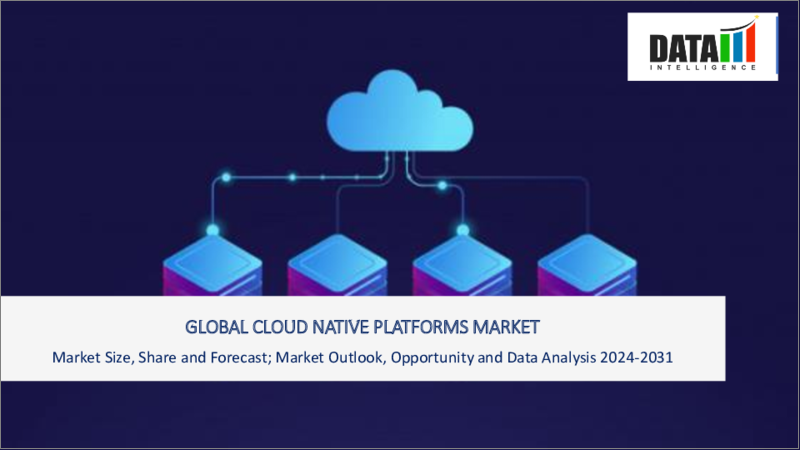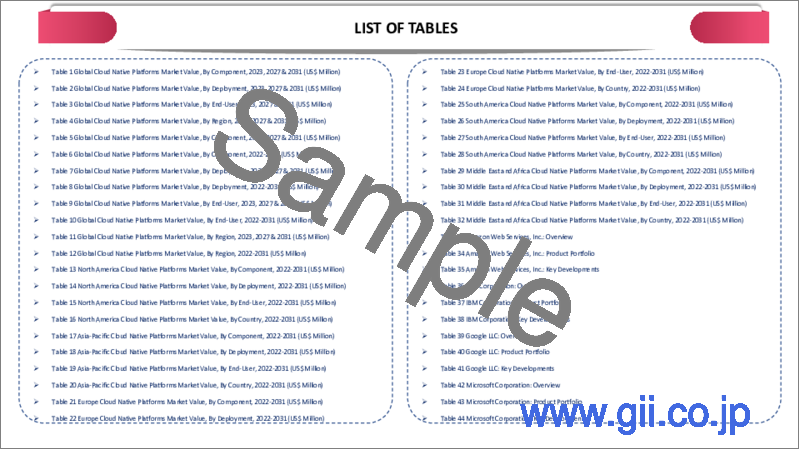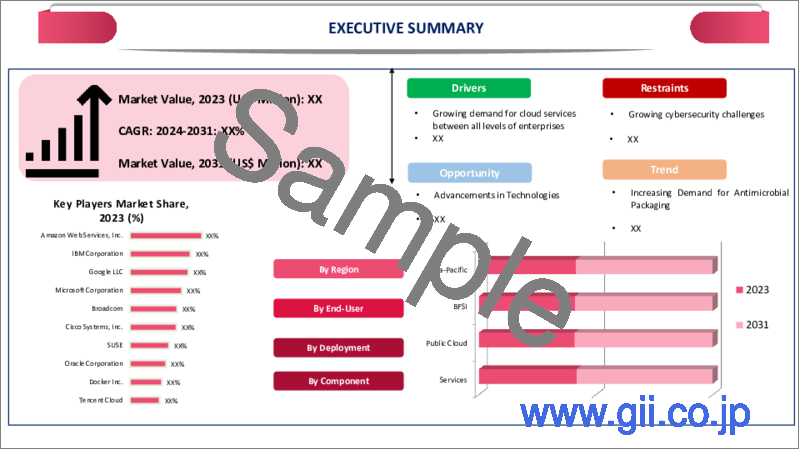|
|
市場調査レポート
商品コード
1396633
クラウドネイティブプラットフォームの世界市場-2023年~2030年Global Cloud Native Platforms Market - 2023-2030 |
||||||
カスタマイズ可能
適宜更新あり
|
|||||||
| クラウドネイティブプラットフォームの世界市場-2023年~2030年 |
|
出版日: 2023年12月15日
発行: DataM Intelligence
ページ情報: 英文 190 Pages
納期: 即日から翌営業日
|
- 全表示
- 概要
- 目次
概要
世界のクラウドネイティブプラットフォーム市場は、2022年に49億米ドルに達し、2023年から2030年の予測期間中にCAGR 24.1%で成長し、2030年には274億米ドルに達すると予測されています。
世界のクラウドネイティブプラットフォーム市場は、クラウドネイティブアーキテクチャを採用する企業が増えていることから、力強い成長を遂げています。クラウドネイティブソリューションは、俊敏性、拡張性、コスト効率を提供し、その採用を促進しています。このシフトにより、新たな役割と製品指向のオペレーティング・モデルが必要となります。さらに、ローコードやノーコード技術の急増により、アプリケーション開発がより身近で効率的になり、市場の拡大が後押しされています。
2022年12月、IBMのマネージド・インフラストラクチャ・サービス部門であったキンドリルは、クラウドネイティブサービスを発表し、クラウド・アプリケーションの近代化における企業の取り組みを支援しました。このサービスは、企業がオンプレミスのアプリケーションをAmazon Web Services(AWS)、Google Cloud(GCP)、Microsoft Azureなどのパブリッククラウドプラットフォームに移行することを可能にします。Kyndrylはまた、ハイブリッド環境またはマルチクラウド環境におけるこれらのクラウドアプリケーションの管理サービスも提供しています。
クラウドネイティブプラットフォーム市場で最大のシェアを占めるのは北米です。Forresterのレポートによると、米国とカナダでは、企業インフラの意思決定者のかなりの部分がクラウドの導入を積極的に受け入れています。コンテナ化やサーバーレス・コンピューティングのようなクラウドネイティブの手法が一般的になりつつある中、モダナイゼーションとクラウドネイティブのアプローチは、これらの組織にとって最優先事項となっています。さらに、米国ではCOVID-19の大流行によってクラウドの導入が加速しており、さまざまな業界でクラウドサービスの重要性が高まっています。
力学
世界のパブリッククラウドへの支出が爆発的に増加
2023年、世界のクラウドネイティブプラットフォーム市場は、公開会社がパブリッククラウドのアプリケーションとインフラへの支出を増やすにつれて拡大しています。ハイパースケーラは競争の激化に直面しており、マルチクラウド採用へのシフトを推進しています。クラウドへの投資は一般的になりつつあるが、アナリストは企業がより高い価値を求める中、コスト効率の高いソリューションの必要性を強調しています。ESGの調査によると、59%がパブリック・クラウド・アプリケーション、56%がインフラ・サービスへの支出増加を計画しています。
マルチクラウド・アプローチが普及しており、26%が2つのパブリッククラウドを、23%が3つのパブリッククラウドを、42%が4つ以上のパブリッククラウドを利用しています。クラウドネイティブのセキュリティへの投資は55%増加すると予想されています。フォレスター・リサーチでは、オラクル・クラウド・インフラストラクチャーとアカマイ・テクノロジーズがAWSの優位性に課題し、クラウドサービス間の価格競争が激化すると予測しています。クラウドの導入が進むにつれ、企業はダイナミックな市場において柔軟性、コスト削減、支出の最適化を求めています。
クラウドネイティブ市場の急成長:ハイブリッドワークソリューションにSASEを採用
2023年、世界のクラウドネイティブプラットフォーム市場は、セキュア・アクセス・サービス・エッジ(SASE)のようなプラットフォームが大幅な成長を遂げようとしています。ハイブリッドワークシナリオがネットワーキングとセキュリティサービスの融合を推進する中、G2はクラウドエッジセキュリティカテゴリへのトラフィックが引き続き192%急増すると予測しています。クラウドベースのサービスにネットワークとセキュリティ・ソリューションを組み合わせたSASEアーキテクチャは、パンデミックのような世界のイベントによるネットワーク・トラフィックの増加に対応します。
G2のデータでは、コラボレーションと生産性カテゴリが大きく成長しており、Virtual Workplacesサブカテゴリは2022年に178%拡大することが明らかになっています。クラウド・アクセス・セキュリティ・ブローカー(CASB)、ゼロ・トラスト・ネットワーク・アクセス(ZTNA)、セキュア・ウェブ・ゲートウェイ(SWG)を含むSASEのコンポーネントは、ハイブリッドワークが進む中、ネットワークへのアクセス性、効率性、セキュリティの強化を求める企業に評価されている、簡素化されたクラウドネイティブのソリューションを提供します。
高まるサイバーセキュリティ課題
クラウドネイティブプラットフォーム市場は、サイバーセキュリティの問題に大きな影響を受けています。クラウドネイティブアプリケーションは、コンテナベースの脆弱性、安全でないAPI、データ侵害、安全でないネットワーク接続、クラウドの誤設定など、さまざまなセキュリティリスクの影響を受けやすいです。脆弱性は、データ盗難、データ損失、コンプライアンス違反、組織の評判へのダメージなど、深刻な結果をもたらします。
現在、企業は、機密データを保護し、顧客やパートナーの信頼を維持するために、ID・アクセス管理、暗号化、継続的な監視、セキュリティ監査などの強固なセキュリティ対策を優先しています。クラウドネイティブプラットフォームのセキュリティを確保することは、データ保護とプライバシーが最重要課題であるテクノロジー状況において最も重要です。
目次
第1章 調査手法と調査範囲
第2章 定義と概要
第3章 エグゼクティブサマリー
第4章 市場力学
- 影響要因
- 促進要因
- 世界のパブリッククラウドへの支出の爆発的成長
- クラウドネイティブ市場の急増:ハイブリッドワークソリューションへのSASEの採用
- 抑制要因
- 高まるサイバーセキュリティ課題
- 機会
- 影響分析
- 促進要因
第5章 業界分析
- ポーターのファイブフォース分析
- サプライチェーン分析
- 価格分析
- 規制分析
- ロシア・ウクライナ戦争の影響分析
- DMIの見解
第6章 COVID-19分析
第7章 コンポーネント別
- ソリューション
- サービス
第8章 デプロイメント別
- プライベートクラウド
- パブリッククラウド
- ハイブリッドクラウド
第9章 エンドユーザー別
- IT・通信
- BFSI
- 小売・eコマース
- メディア&エンターテイメント
- 政府機関
- ヘルスケア&ライフサイエンス
- その他
第10章 地域別
- 北米
- 米国
- カナダ
- メキシコ
- 欧州
- ドイツ
- 英国
- フランス
- イタリア
- ロシア
- その他欧州
- 南米
- ブラジル
- アルゼンチン
- その他南米
- アジア太平洋
- 中国
- インド
- 日本
- オーストラリア
- その他アジア太平洋地域
- 中東・アフリカ
第11章 競合情勢
- 競合シナリオ
- 市況/シェア分析
- M&A分析
第12章 企業プロファイル
- Infosys Corp.
- 会社概要
- コンポーネント・ポートフォリオと説明
- 財務概要
- 主な発展
- Bacancy technology Pvt ltd.
- Pivotal infrastructure Pvt ltd.
- Cloudhelix Limited.
- LTI Infotech Corp.
- Computaris Inc.
- Cognizant Technology Inc.
- IndiaNIC infotech ltd
- Infostretch corporation
- Sciencesoft Corp.
第13章 付録
Overview
Global Cloud Native Platforms Market reached US$ 4.9 billion in 2022 and is expected to reach US$ 27.4 billion by 2030, growing with a CAGR of 24.1% during the forecast period 2023-2030.
The global cloud-native platform market is experiencing robust growth as organizations increasingly embrace cloud-native architectures. Cloud-native solutions offer agility, scalability and cost-efficiency, driving their adoption. The shift necessitates new roles and a product-oriented operating model. Furthermore, the market's expansion is propelled by the surge in low-code and no-code technologies, making application development more accessible and efficient.
In December 2022, Kyndryl, formerly IBM's Managed Infrastructure Services unit, introduced Cloud Native Services to support enterprise efforts in modernizing their cloud applications. The services enable businesses to migrate their on-premises applications to public cloud platforms like Amazon Web Services (AWS), Google Cloud (GCP) and Microsoft Azure. Kyndryl also offers management services for these cloud applications in hybrid or multicloud environments.
North America holds the largest share in the cloud-native platform market. Forrester reports that in both U.S. and Canada, a significant portion of enterprise infrastructure decision-makers are actively embracing cloud deployments. Modernization and cloud-native approaches are high priorities for these organizations, with cloud-native practices like containerization and serverless computing becoming increasingly common. Furthermore, the COVID-19 pandemic has accelerated cloud adoption in U.S., with a growing importance attributed to cloud services in various industries.
Dynamics
Explosive Growth in Global Public Cloud Spending
In 2023, the global cloud-native platform market is expanding as companies increase spending on public cloud applications and infrastructure. Hyperscalers face heightened competition, driving a shift toward multi-cloud adoption. Despite cloud spending becoming commonplace, analysts emphasize the need for cost-effective solutions, as organizations seek better value. ESG survey reveals that 59% plan to increase spending on public cloud applications and 56% on infrastructure services.
Multi-cloud approaches are prevalent, with 26% using two public clouds, 23% using three and 42% using four or more. Cloud-native security investment is expected to rise by 55%. Forrester Research anticipates increased price competition among cloud services, with Oracle Cloud Infrastructure and Akamai Technologies challenging AWS dominance. As cloud adoption continues, companies seek flexibility, cost reduction and optimized spending in a dynamic market.
Cloud-Native Market Surge: Embracing SASE for Hybrid Work Solutions
In 2023, the globally cloud-native platform market, the platform like Secure Access Service Edge (SASE), is poised for substantial growth. As hybrid work scenarios drive the convergence of networking and security services, G2 predicts a continued 192% surge in traffic to the Cloud Edge Security category. The SASE architecture, combining network and security solutions in a cloud-based service, addresses the increased network traffic resulting from global events like the pandemic.
G2's data reveals significant growth in collaboration and productivity categories, with the Virtual Workplaces subcategory expanding by 178% in 2022. SASE components, including Cloud Access Security Broker (CASB), Zero Trust Network Access (ZTNA) and Secure Web Gateway (SWG), offer a simplified, cloud-native solution appreciated by enterprises seeking enhanced accessibility, efficiency and security for their networks amid the ongoing rise of hybrid work.
Rising Cybersecurity Challenges
The cloud native platform market is significantly impacted by cybersecurity issues. The cloud native applications are more susceptible to various security risks, such as container-based vulnerabilities, unsecured APIs, data breaches, insecure network connections and cloud misconfigurations. The vulnerabilities will result in severe consequences which can include data theft, data loss, compliance breaches and damage to an organization's reputation.
Nowadays, businesses are prioritizing robust security measures like identity and access management, encryption, continuous monitoring and security audits which can protect sensitive data and maintain the trust of customers and partners. Ensuring the security of cloud-native platforms is paramount in a technology landscape where data protection and privacy are paramount concerns.
Segment Analysis
The global cloud native platforms market is segmented based on component, deployment, end-user and region.
Hybrid Cloud Dominance: A Solution for Seamless Cloud-Native Transition
Hybrid cloud solutions have gained dominance in the cloud-native platform market due to their unique advantages. Combining both public and private clouds, hybrid architectures provide flexibility, scalability and cost-efficiency while maintaining data control. The setup allows seamless workload migration between private and public environments, adapting to business needs. Benefits include flexibility, scalability, cost-effectiveness and enhanced security. Nevertheless, managing hybrid environments can be complex and security and investment in both private and public cloud resources are challenges.
In April 2023, Cognizant announced the launch of "Cognizant Skygrade," a robust multi-hybrid cloud and edge management platform tailored to assist organizations in transitioning to modern cloud-native architectures and optimizing their cloud management operations. Skygrade is designed to streamline the cloud journey for businesses by offering a curated library of solution accelerators tailored to specific industries. The approach enables enterprises to unlock greater business value swiftly and efficiently, while also promoting simplification, sustainability and cost-effectiveness.
Geographical Penetration
North America Leads Cloud-Native Platform Market as Top Providers Compete
North America commands the Cloud Native platforms market, notably in healthcare, where cloud market share is forecasted to rise by US$ 25.54 billion from 2020 to 2025 as per AAG IT Service report. The U.S. plays a central role, driving a substantial 40% growth in healthcare cloud computing. The dominance is rooted in the region's advanced technological infrastructure, a robust IT ecosystem and a concerted emphasis on digital transformation.
North America's proactive adoption and expansion of cloud-native platforms underscore its position as a global leader in shaping the evolution of cloud services. The significant investment in healthcare cloud solutions reflects the region's commitment to leveraging advanced technologies for enhanced efficiency and innovation, solidifying North America's pivotal role in influencing the trajectory of cloud computing across vital sectors.
COVID-19 Impact Analysis
The COVID-19 pandemic has accelerated the adoption of cloud-native IT solutions. As businesses swiftly moved online to adapt to remote work models, cloud-native ecosystems, technologies and Kubernetes gained momentum. Traditional IT vendors began recognizing and supporting cloud-native technologies. Kubernetes and containers, which are pivotal to cloud-native development, saw substantial adoption, with Kubernetes being used by 78% of companies that utilize containers in production.
Cloud-native approaches require a mindset shift and infrastructure as code. Data management, data protection and observability became key challenges in cloud-native environments. Self-service capabilities are evolving, enabling developers to deploy and manage resources independently. Multi-cluster management and security remain significant concerns in the cloud-native landscape.
Russia-Ukraine War Impact Analysis
The Russia-Ukraine war played a role in escalation in cyber-attacks, with both state-sponsored threat actors and opportunistic cyber-criminals targeting Ukrainian entities. Cloud services have become a preferred attack vector due to their flexibility, resilience and trustworthiness. Threat actors have exploited platforms like Discord for content delivery and abuse, with Discord's content delivery network used to host and distribute malicious payloads.
Furthermore, cloud storage services such as Microsoft OneDrive and Google Drive have played a role in attack campaigns, with phishing emails containing links to malicious documents hosted on these platforms. The reliance on cloud services for malicious activities has become a well-established modus operandi for cyber-attackers in the context of the ongoing conflict. Security measures to counter cloud-native threats must go beyond cloud service providers and organizations need to adopt comprehensive cloud-delivered security platforms for protection.\
AI Impact Analysis
AI is significantly impacting the cloud-native platform market by enhancing automation, security and efficiency. AI technologies are being used to optimize resource allocation, improve performance monitoring and enhance cybersecurity within cloud-native environments. Machine learning and AI-driven analytics enable predictive maintenance and self-healing systems, reducing downtime and enhancing reliability. Moreover, AI plays a vital role in managing the complexity of modern cloud-native applications, making them more resilient and adaptable to changing workloads and user demands.
Sopra Banking Software (SBS) has introduced its SBP Core Platform, an AI-enabled core banking system that leverages cloud technology. The platform boasts open architecture, high scalability and integrated AI features, designed to support various banking services, including deposits, payments, lending, compliance and regulatory reporting. SBS's Digital Engagement Platform is seamlessly integrated with the SBP Core Platform, offering a cost-effective and quick-to-market solution for banks seeking comprehensive banking services.
By Component
- Solution
- Service
By Deployment
- Private Cloud
- Public Cloud
- Hybrid Cloud
By End-User
- IT & Telecom
- BFSI
- Retail and E-commerce
- Media & Entertainment
- Government
- Healthcare & Life Science
- Others
By Region
- North America
- U.S.
- Canada
- Mexico
- Europe
- Germany
- UK
- France
- Italy
- Russia
- Rest of Europe
- South America
- Brazil
- Argentina
- Rest of South America
- Asia-Pacific
- China
- India
- Japan
- Australia
- Rest of Asia-Pacific
- Middle East and Africa
Key Developments
- On March 14, 2023, Intellect Design Arena launched eMACH.ai, the world's largest open finance platform designed to assist banks and financial institutions in creating future-ready technology solutions. The cloud-native platform incorporates artificial intelligence powered by Amazon Web Services (AWS). eMACH.ai offers 285 pre-built microservices, 1,214 APIs and 200 events available on the cloud, enabling financial institutions to innovate and develop market-leading solution.
- In May 2023, NVIDIA introduced the NVIDIA Spectrum-X, an accelerated networking platform designed to enhance the performance and efficiency of Ethernet-based AI clouds. The platform combines the NVIDIA Spectrum-4 Ethernet switch and the NVIDIA BlueField-3 DPU, resulting in a 1.7x improvement in overall AI performance and power efficiency. The NVIDIA Spectrum-X platform is empowered by NVIDIA's acceleration software and SDKs, enabling developers to build software-defined, cloud-native AI applications.
- In October 2023, Microsoft introduced Radius, an open-source, language-agnostic application platform designed for building and running cloud-native applications. Developed within the Microsoft Azure Incubation team, this platform offers the capability to deploy applications in private clouds, Microsoft Azure and Amazon AWS, with Google Cloud support coming soon. Radius is focused on abstracting the complexities of cloud-native applications, enabling developers to concentrate on writing their applications. Unlike some other platforms, Radius aims to be flexible, supporting various application architectures and accommodating complex microservices-based applications.
Competitive Landscape
The major global players in the market include: Infosys Corp., Bacancy technology Pvt ltd., Pivotal infrastructure Pvt ltd., Cloudhelix Limited., LTI Infotech Corp., Computaris Inc., Cognizant Technology Inc., IndiaNIC infotech ltd, Infostretch corporation and Sciencesoft Corp.
Why Purchase the Report?
- To visualize the global cloud native platforms market segmentation based on component, deployment, end-user and region, as well as understand key commercial assets and players.
- Identify commercial opportunities by analyzing trends and co-development.
- Excel data sheet with numerous data points of cloud native platforms market-level with all segments.
- PDF report consists of a comprehensive analysis after exhaustive qualitative interviews and an in-depth study.
- Component mapping available as excel consisting of key Components of all the major players.
The global cloud native platforms market report would provide approximately 61 tables, 60 figures and 190 Pages.
Target Audience 2023
- Manufacturers/ Buyers
- Industry Investors/Investment Bankers
- Research Professionals
- Emerging Companies
Table of Contents
1. Methodology and Scope
- 1.1. Research Methodology
- 1.2. Research Objective and Scope of the Report
2. Definition and Overview
3. Executive Summary
- 3.1. Snippet by Component
- 3.2. Snippet by Deployment
- 3.3. Snippet by End-User
- 3.4. Snippet by Region
4. Dynamics
- 4.1. Impacting Factors
- 4.1.1. Drivers
- 4.1.1.1. Explosive Growth In Global Public Cloud Spending
- 4.1.1.2. Cloud-Native Market Surge: Embracing SASE for Hybrid Work Solutions
- 4.1.2. Restraints
- 4.1.2.1. Rising Cybersecurity Challenges
- 4.1.3. Opportunity
- 4.1.4. Impact Analysis
- 4.1.1. Drivers
5. Industry Analysis
- 5.1. Porter's Five Force Analysis
- 5.2. Supply Chain Analysis
- 5.3. Pricing Analysis
- 5.4. Regulatory Analysis
- 5.5. Russia-Ukraine War Impact Analysis
- 5.6. DMI Opinion
6. COVID-19 Analysis
- 6.1. Analysis of COVID-19
- 6.1.1. Scenario Before COVID
- 6.1.2. Scenario During COVID
- 6.1.3. Scenario Post COVID
- 6.2. Pricing Dynamics Amid COVID-19
- 6.3. Demand-Supply Spectrum
- 6.4. Government Initiatives Related to the Market During Pandemic
- 6.5. Manufacturers Strategic Initiatives
- 6.6. Conclusion
7. By Component
- 7.1. Introduction
- 7.1.1. Market Size Analysis and Y-o-Y Growth Analysis (%), By Component
- 7.1.2. Market Attractiveness Index, By Component
- 7.2. Solution*
- 7.2.1. Introduction
- 7.2.2. Market Size Analysis and Y-o-Y Growth Analysis (%)
- 7.3. Service
8. By Deployment
- 8.1. Introduction
- 8.1.1. Market Size Analysis and Y-o-Y Growth Analysis (%), By Deployment
- 8.1.2. Market Attractiveness Index, By Deployment
- 8.2. Private Cloud*
- 8.2.1. Introduction
- 8.2.2. Market Size Analysis and Y-o-Y Growth Analysis (%)
- 8.3. Public Cloud
- 8.4. Hybrid Cloud
9. By End-User
- 9.1. Introduction
- 9.1.1. Market Size Analysis and Y-o-Y Growth Analysis (%), By End-User
- 9.1.2. Market Attractiveness Index, By End-User
- 9.2. IT & Telecom*
- 9.2.1. Introduction
- 9.2.2. Market Size Analysis and Y-o-Y Growth Analysis (%)
- 9.3. BFSI
- 9.4. Retail and E-commerce
- 9.5. Media & Entertainment
- 9.6. Government
- 9.7. Healthcare & Life science
- 9.8. Others
10. By Region
- 10.1. Introduction
- 10.1.1. Market Size Analysis and Y-o-Y Growth Analysis (%), By Region
- 10.1.2. Market Attractiveness Index, By Region
- 10.2. North America
- 10.2.1. Introduction
- 10.2.2. Key Region-Specific Dynamics
- 10.2.3. Market Size Analysis and Y-o-Y Growth Analysis (%), By Component
- 10.2.4. Market Size Analysis and Y-o-Y Growth Analysis (%), By Deployment
- 10.2.5. Market Size Analysis and Y-o-Y Growth Analysis (%), By End-User
- 10.2.6. Market Size Analysis and Y-o-Y Growth Analysis (%), By Country
- 10.2.6.1. U.S.
- 10.2.6.2. Canada
- 10.2.6.3. Mexico
- 10.3. Europe
- 10.3.1. Introduction
- 10.3.2. Key Region-Specific Dynamics
- 10.3.3. Market Size Analysis and Y-o-Y Growth Analysis (%), By Component
- 10.3.4. Market Size Analysis and Y-o-Y Growth Analysis (%), By Deployment
- 10.3.5. Market Size Analysis and Y-o-Y Growth Analysis (%), By End-User
- 10.3.6. Market Size Analysis and Y-o-Y Growth Analysis (%), By Country
- 10.3.6.1. Germany
- 10.3.6.2. UK
- 10.3.6.3. France
- 10.3.6.4. Italy
- 10.3.6.5. Russia
- 10.3.6.6. Rest of Europe
- 10.4. South America
- 10.4.1. Introduction
- 10.4.2. Key Region-Specific Dynamics
- 10.4.3. Market Size Analysis and Y-o-Y Growth Analysis (%), By Component
- 10.4.4. Market Size Analysis and Y-o-Y Growth Analysis (%), By Deployment
- 10.4.5. Market Size Analysis and Y-o-Y Growth Analysis (%), By End-User
- 10.4.6. Market Size Analysis and Y-o-Y Growth Analysis (%), By Country
- 10.4.6.1. Brazil
- 10.4.6.2. Argentina
- 10.4.6.3. Rest of South America
- 10.5. Asia-Pacific
- 10.5.1. Introduction
- 10.5.2. Key Region-Specific Dynamics
- 10.5.3. Market Size Analysis and Y-o-Y Growth Analysis (%), By Component
- 10.5.4. Market Size Analysis and Y-o-Y Growth Analysis (%), By Deployment
- 10.5.5. Market Size Analysis and Y-o-Y Growth Analysis (%), By End-User
- 10.5.6. Market Size Analysis and Y-o-Y Growth Analysis (%), By Country
- 10.5.6.1. China
- 10.5.6.2. India
- 10.5.6.3. Japan
- 10.5.6.4. Australia
- 10.5.6.5. Rest of Asia-Pacific
- 10.6. Middle East and Africa
- 10.6.1. Introduction
- 10.6.2. Key Region-Specific Dynamics
- 10.6.3. Market Size Analysis and Y-o-Y Growth Analysis (%), By Component
- 10.6.4. Market Size Analysis and Y-o-Y Growth Analysis (%), By Deployment
- 10.6.5. Market Size Analysis and Y-o-Y Growth Analysis (%), By End-User
11. Competitive Landscape
- 11.1. Competitive Scenario
- 11.2. Market Positioning/Share Analysis
- 11.3. Mergers and Acquisitions Analysis
12. Company Profiles
- 12.1. Infosys Corp.*
- 12.1.1. Company Overview
- 12.1.2. Component Portfolio and Description
- 12.1.3. Financial Overview
- 12.1.4. Key Developments
- 12.2. Bacancy technology Pvt ltd.
- 12.3. Pivotal infrastructure Pvt ltd.
- 12.4. Cloudhelix Limited.
- 12.5. LTI Infotech Corp.
- 12.6. Computaris Inc.
- 12.7. Cognizant Technology Inc.
- 12.8. IndiaNIC infotech ltd
- 12.9. Infostretch corporation
- 12.10. Sciencesoft Corp.
LIST NOT EXHAUSTIVE
13. Appendix
- 13.1. About Us and Services
- 13.2. Contact Us





